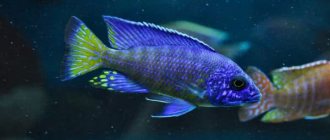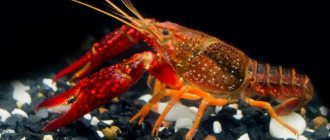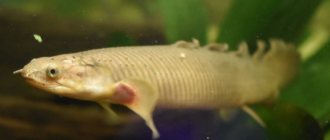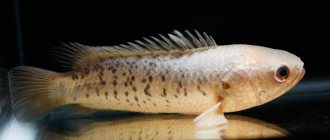Speckled catfish or straw shelled catfish are a popular fish for breeding at home. Thanks to its peaceful nature, easy care and simplicity, it has won the love of aquarists.
In nature, catfish inhabit clean reservoirs with standing water or weak currents. Preference is given to shallow water overgrown with algae. Corydoras are widespread in the river basins of the South American continent, Uruguay, Paraguay, Brazil and Argentina.
The scientific name Corydoras paleatus comes from the combination of the Latin words “cory, doras, palea” and means “helmet, skin and ashes”.
Description
The speckled catfish has several distinctive features in appearance:
- Adult inhabitants of aquariums reach sizes of 6.5 cm for males and 7.5 cm for females.
- Two pairs of whiskers help in searching for food.
- Pale olive body color with a scattering of dark spots unique to each individual. May have a green or blue tint.
- The dorsal fin has a dark stripe, the rest are transparent.
- The spines on the fins and under the eyes play a protective function. When transplanting, do not use nets on which the spotted catfish can get caught.
Individuals living in nature have a pronounced contrast.
Behavior
The aquarium catfish is very active, but is capable of remaining motionless for a long time in order to obtain food. Refers to peaceful fish.
When there is a lack of oxygen, it rises to the surface.
Juveniles when very frightened and pairs during spawning are able to make sounds using their pectoral fins.
Lifespan
Speckled ones live 6–8 years, depending on the conditions of detention. Water temperature has a strong influence on metabolism. The warmer it is, the shorter the catfish will live.
Varieties
Currently, about 200 species of speckled corydoras are known. They are the most common bottom dwellers in home aquariums. Among the most popular are:
Golden
The name Golden Catfish is derived from its golden coloration. A bright stripe of a gilded hue runs along the entire length of the body from head to tail. Females can be distinguished from males by the presence of rounded fins.
Catfish Panda
Externally, the coloring resembles a panda - black spots can be seen on the white body around the eyes and on the fins. These individuals are relatively small in size, no more than 3-4 cm. Until the age of 1 year, sexual characteristics are practically indistinguishable.
Adolfi
It has an unusual white-pinkish color. The disadvantage of this species is that it is very difficult to reproduce individuals.
Agasitsa
Pale yellow with a gray tint and black spots, a small catfish up to 5 cm in size gets along well with other inhabitants of the aquarium.
Veiled catfish
The veiled catfish is called because of its elongated lateral fins and tail, which develop like a veil while swimming.
Almost all types of corydoras have veil forms: golden, shterba, speckled, panda, albino.
Shterba
It has a spotted leopard coloring - many golden spots are scattered on the brown body. It is also unpretentious in maintenance, like other relatives.
Kinds
In nature, there are a considerable number of varieties of catfish. The main difference between the breeds is their color.
Catfish panda
The panda is distinguished by a combination of stripes on its body, repeating the color of the big Panda. Hardy, easy to breed. Habitat: Amazon basins. It feels comfortable in an aquarium with sufficient shade, river sand and a large number of plants. Omnivorous. Sex differences are minimal until one year of age. The adult female is larger, the abdominal line is arched.
Habitat of synodontis
The fish live in the reservoirs of Central, Eastern and Western Africa, in the basins of the Congo, Niger, Nile, Zambezi, Ivindo rivers, lakes Chad, Malawi, Tanganyika, Victoria, Tana, Rukwa. The genus Synodonts includes 131 species. Synodontis were brought to Europe in 1950. Today, fish come mainly from three regions: West Africa (mainly Nigeria), Zaire (“Congo”) and rift lakes.
Content
Keeping speckled catfish does not require much effort, but you need to create favorable conditions for life in the aquarium.
Water parameters
The speckled catfish feels comfortable with the following water parameters:
- acidity 6–7 pH;
- hardness 10 dGH;
- temperature 22–26 °C.
Perform a partial water change once a week, and a complete water change along with cleaning the soil once a month. This will help avoid the accumulation of nitrates and rotting products.
Aquarium
A volume of 55–60 liters will be sufficient for 3–4 pets.
Priming
River sand without large and sharp stones. Such soil will not damage the delicate antennae and will be convenient for searching for food.
Aeration
Catfish can rise to the surface for oxygen. Make sure that the plants do not occupy the entire area and that the fish have access to fresh air.
Plants
Fill the aquarium with plants with strong roots or additionally secure them, since speckled ones have a habit of digging up algae. Shelters in the form of grottoes and snags are necessary for the comfort of aquarium fish.
Lighting
Diffused light is preferred. Floating plants will help achieve the required conditions.
CATFISH CATFISH
Type of synodontis - catfish changeling
Habitat: Zaire; Content difficulties: easy; Water parameters in the aquarium: t 24 - 27 C; pH 6.8 – 7.0; dH 10; Life expectancy: up to 10 years; Aquarium size: at least 50 l. 2-3 times more is better; Body length: males - up to 6 cm, females - up to 10 cm; Behavior: peaceful; Diet: omnivorous.
The body color of the fish is brown with small dark spots. The body is stocky, somewhat flattened on the sides. The back is more convex than the abdomen, the eyes are large, the mouth is lower with three pairs of antennae, the caudal fin is two-lobed. The dorsal fin is triangular in shape and has a powerful first ray. Large adipose fin. Individuals of this species spend a significant part of their time with their belly up. This feature gave rise to the name Synodontis nigriventris catfish-shifters. In their natural habitat, skinwalkers swim in large schools of thousands of individuals. Therefore, it is recommended to purchase at least three fish. This will allow you to observe the natural group behavior of the skinwalkers.
SYNODONTIS GAMBIENSIS GAMBIAN SYNODONTIS
Habitat: Western Africa; Content difficulties: easy; Body length: up to 30cm; Behavior: may be aggressive; Diet: omnivorous.
Fish of this variety are easy to identify by their monotonous gray color. The ventral side of the body and antennae are whitish. There are several vague dark stripes on the caudal fin.
SYNODONTIS OCELLIFER
Care
They prefer cool water, so in summer it is necessary to monitor the temperature in the aquarium and, if necessary, lower it.
Avoid high acidity and do not change the conditions for your aquarium fish too suddenly.
What to feed
Catfish eat live food, but will not refuse industrial granules and tablets. The main factor when feeding is the weight of the food. Catfish feed from the bottom. The food remaining on the surface becomes prey for other inhabitants of the aquarium.
Reviews
Among the reviews from aquarium fish owners, you can see only positive ones:
“One of the most beloved inhabitants of the aquarium is the speckled catfish. They are peaceful and easy to care for. The color shimmers in different shades. They are interesting to watch. It’s especially relaxing after work”;
“They appeared in our aquarium a year ago, they get along well with their neighbors - guppies, swordtails and neons. Almost all the time they are at the bottom, sometimes hiding behind snags or in algae. They act as “scavengers” and clean the aquarium well”;
“Funny fish that are on the move almost all the time. They can be called aquarium orderlies. They coexist quite peacefully with other fish. They don’t require any special care.”
Such reviews are based on the unpretentiousness in keeping and breeding speckled corydoras. By maintaining the water in a clean state, the required acidity and temperature, you will ensure your pets have a long stay, and in return they will delight you with lively emotions.
Compatibility
Speckled catfish are peaceful. Treats his own kind well. Keep them in flocks of 3-5 individuals. Gets along well with small fish species:
- barb;
- zebrafish;
- livebearers;
- guppy;
- Killfish.
Consider the dependence of speckled catfish on temperature conditions. Together with heat-loving fish, they will feel uncomfortable.
If corydoras are compatible, avoid proximity to predatory, aggressive species.
Feeding
The speckled catfish is an omnivorous fish: both live food (mosquito larvae, tubifex worms, shrimps, worms, coretras, brine shrimp, daphnia, cyclops, etc.) and dry food: tablets for bottom fish, crushed flakes, etc. mixtures.
Since Straw Shells are predominantly nocturnal, it is recommended to feed them at the end of the day. Nutrition should be combined and balanced. Depending on the variety, the diet may be modified towards a higher protein content or, conversely, with an emphasis on plant ingredients.
Reproduction
Speckled catfish breeding in aquariums began about 100 years ago. The fish are undemanding and easily reproduce in captivity.
Corydoras reach sexual maturity at the age of eight months.
To breed catfish, you need to prepare a separate aquarium with a volume of at least 10 liters. Replace the soil with plants and strengthen them with stones at the bottom. Place the aquarium in a sunny place, increase aeration. The water should be 3-5 degrees colder than usual, this imitates the rainy season - the natural breeding time of speckled fish.
Place one female and 2-3 males in the prepared spawning tank.
To start breeding speckled catfish you need to change your diet. As an impetus for spawning, live food rich in protein is preferred.
Adults must be removed immediately after spawning, as they are capable of eating their own eggs.
Differences between a female and a male
Sexual differences between males and females are pronounced. You can determine the sex of a fish based on several characteristics:
- females are larger in size and have a more rounded abdomen;
- the dorsal fin in males is larger in size, and the anal fin has a more pointed shape;
- The male corydoras is variegated and significantly brighter than the female.
Spawning
Readiness for spawning is shown by the reddened abdomen of the female. Aquarium catfish show great activity and mobility.
The male begins to stimulate the female with the help of his antennae. Then he takes an L-shaped position opposite the partner’s mouth and releases a portion of milk. With its help, the eggs located in the pelvic fins will be fertilized and then glued to the selected and cleaned place.
Breeding
Puberty in Speckled Catfish occurs at the age of 6-8 months. Capable of reproducing up to three times a year.
For spawning fish at home, a separate aquarium with a volume of 30-100 liters is desirable, depending on the number of individuals participating and the method of breeding: nesting (2-3 males per 1 female) or schooling (4-8 males per 2-4 females).
They organize dim light, high-quality filtration and aeration. Take water that has been settled (at least 2 days), at a temperature of +20...+22 °C, acidity pH 6-7, hardness dH up to 15°. Fill the tank up to 15 cm in height.
Substrate is optional, however, Java moss is an excellent option. A plant is placed in the center of the aquarium, the leaves of which will become a good place for laying eggs.
In the evening, the parent individuals are placed in the spawning tank. Provide plenty of nutrition. The catalyst for the reproduction process will be a decrease in temperature by a couple of degrees, as well as the replacement of a significant part of the volume of water and increased aeration.
At first, the males actively flirt with the female, and then the female, having chosen a partner, takes his milk into her mouth and lays several eggs in her pelvic fins folded in an envelope. Having chosen a suitable place, she lubricates the surface with the male’s seminal fluid and glues granules that have undergone fertilization to it. The process is repeated.
In the morning, a few hours later, spawning is completed, and from several tens to several hundred transparent white eggs with a diameter of 1.5-3 mm are formed in the clutch (the quantity depends on the type of catfish and the conditions met). The water is tinted with Methylene blue (up to 5 mg per 1 l) or Sera mycopur to avoid or eliminate mold damage to the granules. White eggs are removed manually. The parents are returned to the community aquarium. Part of the water in the spawning tank is replaced, while otherwise trying to maintain the original parameters of the environment (maintaining high-quality aeration and filtration), however, a slight increase in temperature is acceptable to speed up the incubation process. Ripening lasts from 4 to 12 days.
2 days after hatching, the fry begin to swim freely around the aquarium.
Conditions for keeping young animals:
- temperature +20…+24 °C;
- weak aeration, filtration (using a sponge filter);
- weekly water changes.
Live dust, artemia nauplii, rotifers, ciliates, cyclops, and nematodes are used as starter food. As they grow - crushed oligochaetes, tubifex, flakes.
The growth rate of the brood with proper nutrition is quite fast: by the age of one month they reach about 1 mm in length. At 8-10 weeks, the fry acquire the color characteristic of an adult.
Diseases
Catfish are resistant to diseases, but if not properly cared for they can become susceptible to bacterial and fungal diseases.
Particularly sensitive to nitrate content. Due to the excess content, the antennae of speckled animals die off and the pet dies.
Separate the fish from the rest and begin treatment if signs of the disease appear:
- lethargy;
- lack of appetite;
- folded fins;
- whitish coating;
- color change.
Corydoras do not tolerate salt water. This method of treatment will kill the catfish.
OCULATE SYNODONTIS
Type of synodontis - ocellated
Habitat: Western Africa; Content difficulties: easy; Body length: up to 50 cm; Life expectancy: up to 20 years; Behavior: peaceful; Diet: omnivorous.
The color of this variety of synodontis is light gray, sometimes with a yellowish coating. The body is covered with large, round, black spots. In adults, a white mark may appear in the center of each dark spot. On the back of the fish there is a large fin with sharp spines, so it is not recommended to transport the fish in bags, but use glass or plastic containers for this. Beautiful appearance and ease of maintenance have become the key to the popularity of ocellated synodontis.
SYNODONTIS EUPTERUS
Prices
In pet stores the price tag is higher, on bulletin boards it’s cheaper.
| Size(cm) | Starting price (Russian rubles) |
| Up to 2.5 | 55 |
| 2.5–4 | 75 |
| 4–5 | 90 |
| 5–8 | 180 |
| 8–11 | 200 |
| 11–15 | 250 |
| 15–18 | 300 |
| 18–20 | 400 |
| 20–25 | 500 |
| More than 25 | 1000 |
ONE-SPOTTED OR BLUE SYNODONTIS
Type of synodontis - gray
Habitat: Zaire; Content difficulties: easy; Water parameters in the aquarium: t 22 - 25 C; pH 6.5 – 7.5; dH 8 - 18; Life expectancy: up to 15 years; Aquarium size: at least 150L with plenty of hiding places; Body length: up to 25 cm; Behavior: may be aggressive; Diet: omnivorous.
Gray or single-spotted synodontis has a very attractive appearance. Its body and head are gray-brown in color, and its abdomen is white. There are from one to five round, black spots along the body along the midline. The number of spots on each side of the body may not be the same. There are individuals with spots on only one side or absent altogether. Young single-spotted synodontis are quite sociable and peaceful, but with age, aggression and territorial behavior appears both towards their own species and towards other synodontis. Best kept with large fish, such as West African cichlids.
SYNODONTIS NJASSAE (KEILHACK, 1908)
Adviсe
- In an aquarium with small fish, catfish will eat leftover food and keep the aquarium clean.
- Be careful when purchasing ready-made food. Check the date of manufacture.
- Store food closed to avoid the appearance of pathogenic flora.
Catfish are often sold artificially bred and adapted for home conditions. These fish are an ideal choice for a beginner in aquarium keeping.
Previous
Fish Tips for breeding neons in an aquarium
Next
FishGoldfish Care Guide
SYNODONTIS EUPTERUSE OR VEIL
Type of synodontis - veil
Habitat: Western Africa; Content difficulties: easy; Life expectancy: more than 15 years; Body length: up to 20 cm; Behavior: peaceful; Diet: omnivorous.
The body of adult fish is gray with a yellow or purple tint and covered with small spots; in juveniles it is covered with winding stripes. The dorsal fin already looks veiled in juveniles. As the fish matures, the growth of the fins accelerates due to the lengthening of the soft rays and the membrane surrounding them. It is because of this feature that this species was nicknamed veiled synodontis (from English: Featherfin squeaker - squeaker with feather-like fins). The name comes from the Greek word "Syno", meaning "close" and "odontis", meaning "tooth" - referring to the teeth of the lower jaw of the fish, located close to each other. The second attribute in the name "Eupterus", which means "Beautiful Wings" in Greek, refers to its dorsal fin. Synodontis eupterus is a hardy fish and can adapt to a variety of conditions, making it ideal for beginner aquarists. Fish can often be observed in an upside-down position under overhanging rocks or snags.
SYNODONTIS ANGELICUS (SCHILTHUIS, 1891)











